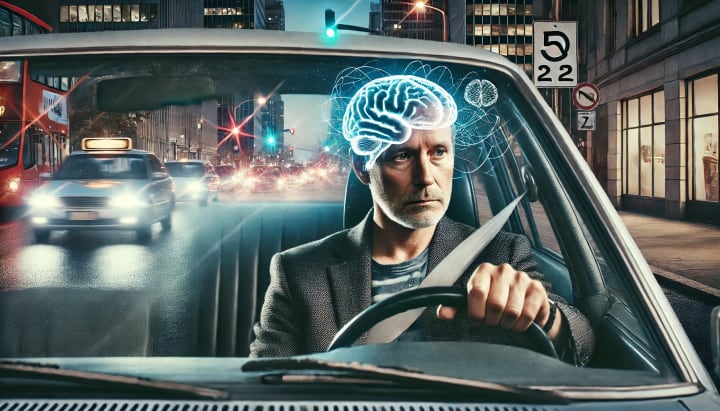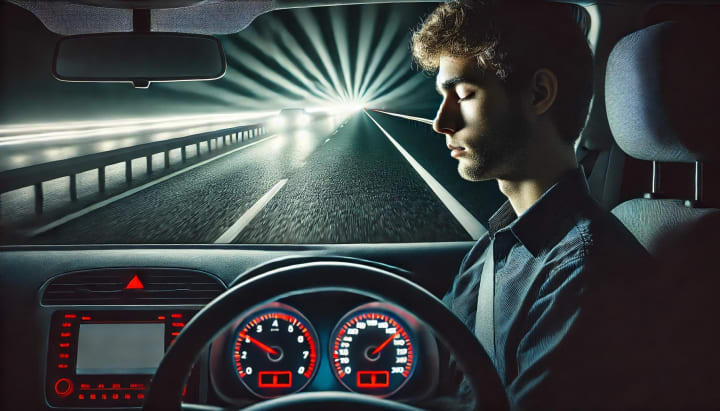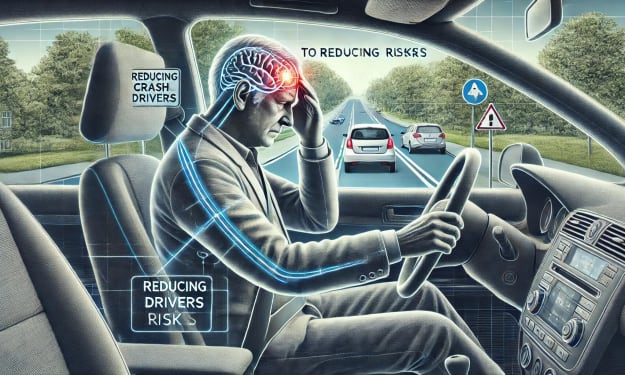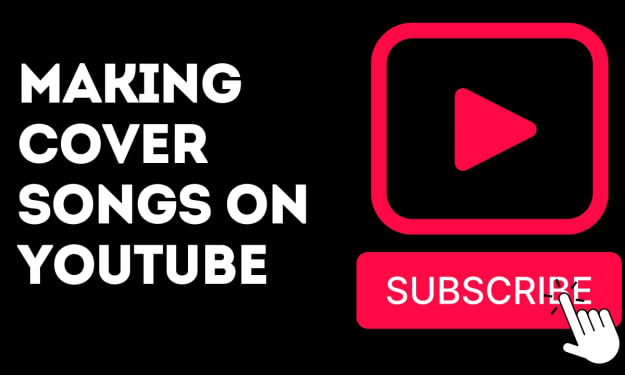Are Your Driving Habits Signaling a Sleep Disorder?
Are Your Driving Habits Pointing to a Sleep Disorder?

Sleep disorders are a significant but often overlooked issue that can severely impact driving abilities. Many people fail to recognize the signs of sleep disorders and how these conditions can affect their driving habits. At Get Drivers Ed, we emphasize the importance of understanding the link between sleep health and safe driving. In this blog, we'll explore how sleep disorders can influence driving habits and provide tips on how to manage them to ensure safety on the road.
The Link Between Sleep Disorders and Driving
Sleep disorders encompass a range of conditions that affect the quality, timing, and amount of sleep, leading to daytime sleepiness and other complications. Common sleep disorders include insomnia, sleep apnea, restless legs syndrome, and narcolepsy. Here's how these conditions can impact driving:
1. Daytime Sleepiness

One of the most apparent symptoms of sleep disorders is excessive daytime sleepiness. This can result in a lack of focus, slower reaction times, and even falling asleep at the wheel, significantly increasing the risk of accidents. For example, drivers with sleep apnea often experience fragmented sleep, which leads to severe daytime drowsiness.
2. Impaired Cognitive Function

Sleep is crucial for cognitive functions such as memory, attention, and decision-making. Sleep disorders can impair these functions, leading to poor judgment and slower responses while driving. Insomnia, for instance, can lead to a state of chronic sleep deprivation, affecting a driver’s ability to concentrate and make quick decisions.
3. Reduced Alertness

Sleep disorders can cause a lack of alertness, making it challenging to stay vigilant on the road. This can result in missing critical signals, such as stop signs and traffic lights, and failing to notice other vehicles or pedestrians. Narcolepsy, which causes sudden sleep attacks, can be particularly dangerous for drivers.
4. Microsleeps

Microsleeps are brief episodes of sleep that last for a few seconds. Drivers with sleep disorders may experience microsleeps without realizing it, which can be extremely dangerous, especially at high speeds. Even a few seconds of inattention can lead to severe accidents.
Identifying Signs of Sleep Disorders in Driving Habits
Recognizing the signs of sleep disorders in your driving habits is the first step towards addressing the issue. Here are some indicators that your driving habits may be pointing to a sleep disorder:
1. Frequent Yawning or Blinking
If you find yourself frequently yawning or blinking while driving, it may be a sign of insufficient sleep or a sleep disorder. This constant need to refresh your alertness indicates your brain is not getting the rest it needs.
2. Drifting Between Lanes
Drifting between lanes or having difficulty maintaining a consistent speed can indicate a lack of focus and alertness due to a sleep disorder. This lack of control is a red flag for potential sleep-related issues.
3. Difficulty Remembering the Drive
If you often arrive at your destination without remembering parts of the drive, this could be a sign of microsleeps or impaired cognitive function caused by a sleep disorder. This “autopilot” mode can be dangerous, especially in unpredictable traffic conditions.
4. Near-Miss Accidents
Experiencing near-miss accidents or frequent close calls can be a warning sign that your sleep health is affecting your driving abilities. These incidents indicate that your reaction times and decision-making skills are compromised.
5. Reliance on Stimulants
Relying on caffeine or other stimulants to stay awake and alert while driving may indicate an underlying sleep disorder that needs to be addressed. Overuse of these substances can mask the symptoms without addressing the root cause.
Managing Sleep Disorders to Improve Driving Safety
If you suspect that a sleep disorder is affecting your driving habits, it's essential to take steps to manage your condition and ensure your safety on the road. Here are some tips from Get Drivers Ed:
1. Seek Medical Advice
Consult a healthcare professional if you experience symptoms of a sleep disorder. They can provide a proper diagnosis and recommend appropriate treatments, such as medication, therapy, or lifestyle changes. Addressing the root cause of your sleep issues is crucial for long-term safety.
2. Establish a Sleep Routine
Maintaining a consistent sleep schedule can help regulate your body's internal clock and improve the quality of your sleep. Aim for 7-9 hours of sleep each night and avoid significant variations in your sleep patterns. Consistency is key to resetting your sleep cycles.
3. Create a Sleep-Friendly Environment
Ensure your bedroom is conducive to sleep by keeping it dark, quiet, and cool. Investing in a comfortable mattress and pillows can also improve sleep quality. Removing electronic devices from the bedroom can reduce distractions.
4. Practice Good Sleep Hygiene
Good sleep hygiene involves habits that promote better sleep, such as avoiding caffeine and heavy meals before bedtime, limiting screen time, and engaging in relaxing activities before bed. Establishing a pre-sleep routine can signal your body that it's time to wind down.
5. Take Breaks on Long Drives
If you feel drowsy while driving, take regular breaks to rest and recharge. Pull over in a safe area and take a short nap if necessary. Even a brief rest can significantly improve alertness.
6. Avoid Driving During Peak Sleepiness
Identify times when you are most likely to feel sleepy, such as late at night or early in the morning, and avoid driving during these periods. Planning your drives for times when you are naturally more alert can reduce risks.
The Role of Drivers Ed in Promoting Safe Driving
At Get Drivers Ed, we understand the importance of addressing all factors that affect driving safety, including sleep health. Our comprehensive drivers ed program covers various aspects of safe driving, including the impact of health conditions like sleep disorders. Here's how our program can help:
1. Education on Health and Driving
Our curriculum includes modules on the relationship between health and driving. We educate students on how conditions like sleep disorders can affect driving abilities and provide tips on managing these conditions. Awareness is the first step towards prevention.
2. Emphasis on Safe Driving Practices
We emphasize the importance of safe driving practices, including recognizing signs of drowsiness and taking appropriate actions to stay alert. Our program teaches defensive driving techniques to help students handle various driving scenarios.
3. Personalized Instruction
Our experienced instructors provide personalized guidance to help students understand how their health can impact their driving. They offer practical tips and strategies for managing health conditions while driving. Individual attention ensures that each student's unique needs are addressed.
4. Flexible Learning Options
Understanding that health conditions can affect learning, we offer flexible learning options, including online courses and weekend classes. This allows students to complete their drivers ed training at a pace that suits their needs and circumstances.
Conclusion: Drive Safely with Get Drivers Ed
Recognizing the signs of sleep disorders in your driving habits and taking steps to manage your condition is crucial for ensuring road safety. At Get Drivers Ed, we are committed to helping drivers understand the impact of sleep health on driving and providing the tools and knowledge needed to stay safe on the road. Enroll in our drivers ed program today to learn more about how to drive safely with sleep disorders and other health conditions. Visit Get Drivers Ed to get started.
By addressing sleep health and its impact on driving, we can help create safer roads for everyone. Your safety and well-being are our top priorities. Join Get Drivers Ed and take control of your driving health today.
About the Creator
Get Drivers Ed
Discover expert tips, driving safety insights, and the latest trends from Get Drivers Ed. Your online guide to mastering the road. Learn, drive, and lead!
Enjoyed the story? Support the Creator.
Subscribe for free to receive all their stories in your feed. You could also pledge your support or give them a one-off tip, letting them know you appreciate their work.






Comments
There are no comments for this story
Be the first to respond and start the conversation.